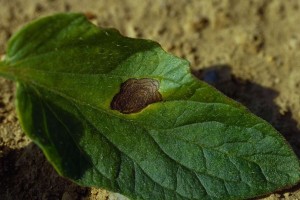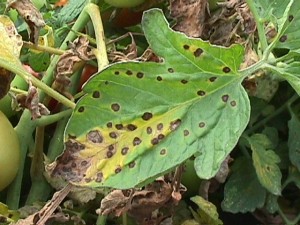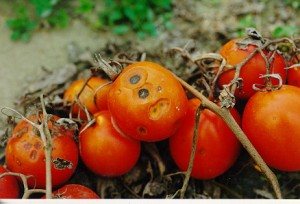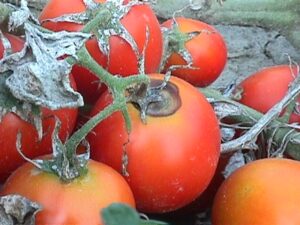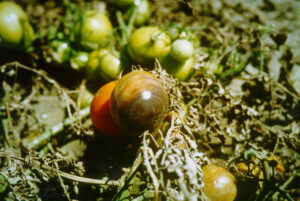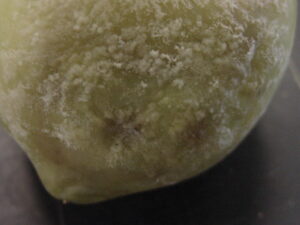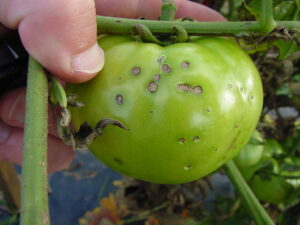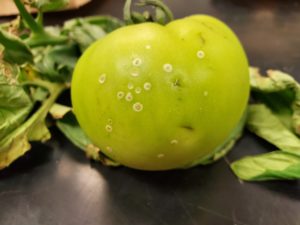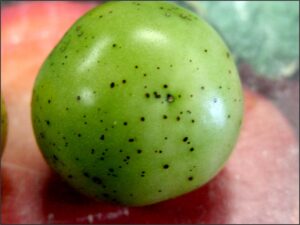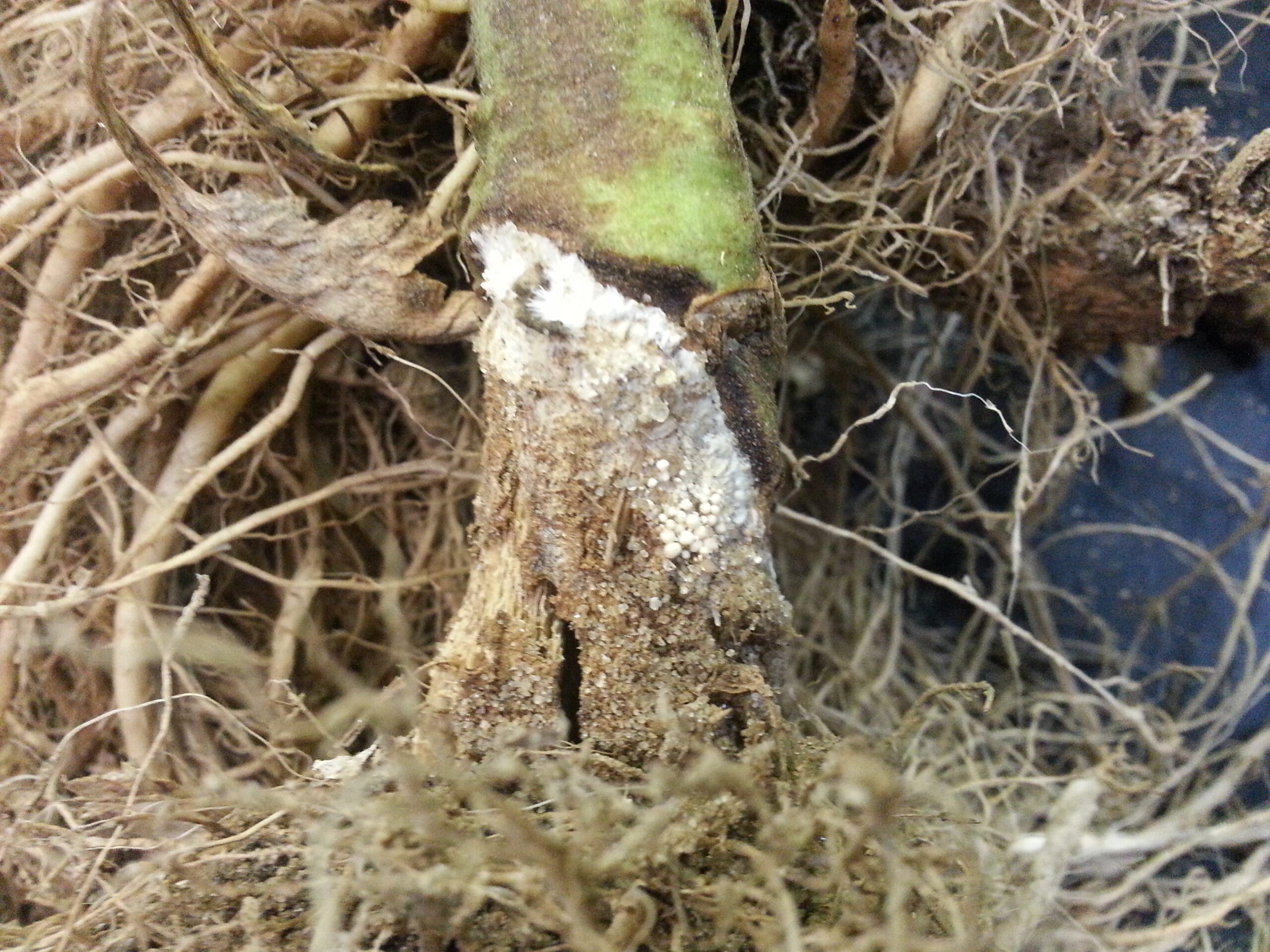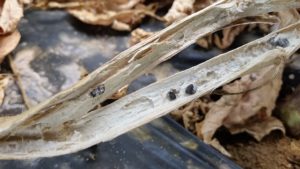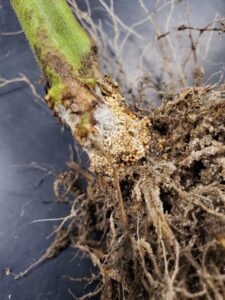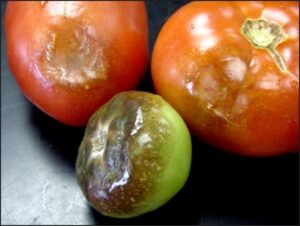Cercospora leaf spot (CLS), caused by Cercospora beticola, is an important and emerging disease in beet and swiss chard production in New Jersey. Efforts to control this disease has become more difficult in the past few years in some areas of southern New Jersey. [Read more…]
Vegetable Crops Edition
Seasonal updates and alerts on insects, diseases, and weeds impacting vegetable crops. New Jersey Commercial Vegetable Production Recommendations updates between annual publication issues are included.
Subscriptions are available via EMAIL and RSS.
Quick Links:
 NJ Commercial Vegetable Production Recommendations
NJ Commercial Vegetable Production Recommendations
 Rutgers Weather Forecasting - Meteorological Information important to commercial agriculture.
Rutgers Weather Forecasting - Meteorological Information important to commercial agriculture.
Agri-Technology and Vegetable Research Twilight Meeting
Where: Rutgers Agricultural Research and Extension Center (RAREC), 121 Northville Rd., Bridgeton, NJ 08302
When: Wednesday August 16, 2023, 5 PM until dark, refreshments and ice cream will be served
This year’s twilight meeting at RAREC will showcase new agricultural technologies for stakeholders in the state. We will showcase the newly installed agrivoltaics system established at RAREC and discuss new technologies for autonomous seeding and weeding as well as drone technologies for improving crop production and decision making.
Agrivoltaics Research at Rutgers – Dan Ward, Director of Rutgers Agricultural Research and Extension Center (RAREC) and the New Jersey Wine Center for Wine Research and Education; and Dave Specca, Rutgers Agrivoltaics Program lead. The demand for clean energy and the development of new technologies for solar electricity generated on producing agricultural land (Agrivoltaics) has driven Rutgers/NJAES to investigate this hybrid technology. We are investigating the effects of putting elevated photovoltaic panels above numerous cropping systems to see what effects the panels have on the crops; and what effects the crops have on the panel’s electrical productivity. Our results will be used in economic models and other recommendations to assist farmers, landowners, and solar developers in deciding whether these combined technologies are a good choice for them.
Presentation and demonstration of Naio OZ autonomous seeding and weeding platforms – Thierry Besançon, Extension Weed Science Specialist for Specialty Crops, Rutgers. The use of small-size electrical autonomous weeders such as the Naio Oz multitask and multi crop robot may help growers to lessen their reliance on fossil fuels for weeding vegetable productions. Using an autonomous weeder can also help alleviating some of the issues with labor availability, especially for burdensome activities such as manual weeding. The GPS guided Naio Oz platform is 100% electric (8 hours autonomy) and versatile through the use a variety of tools (drill, brushes, harrows, hoes blades…) that allow it to weed within and between the crop rows, make furrows, sow, and carry loads to the field. We will present and demonstrate the use of the Naio Oz for autonomous seeding and weeding, and discuss trials currently conducted at RAREC to evaluate weed control efficacy with this system as compared to conventional herbicides.
In-crop cereal cover crop and living mulch trials for vegetables at RAREC – Thierry Besançon, Extension Weed Science Specialist for Specialty Crops, Rutgers. Row-middle weed control in plasticulture vegetable production is becoming increasingly difficult due to a lack of effective herbicides, a need for multiple cultivations, or hand labor. Alternative solutions that integrate multiple weed control tactics are needed to address these issues. One solution is to use cover crops to aid in weed suppression along with an effective herbicide program. A field study is being conducted at RAREC in 2023 to assess the effects of integrating spring-seeded grass cover crops with herbicide treatments for weed control in watermelon. Results from 2023 and from previous studies conducted in 2021 and 2022 show that spring seeded grass cover crops can successfully be integrated with effective herbicide programs for improved weed control between plastic beds.
The potential applications of using drones in agricultural production in New Jersey – Peter Oudemans, Professor and Director P.E. Marucci Center for Blueberry and Cranberry Research and Extension, Rutgers. Drones or UAVs can be used to detect anomalies in agricultural fields to directly determine the impacts of disease, pests, weeds, and soil conditions on crop production. This information can be used to determine economic crop losses, pest management strategies, and provide a wealth of other information that can be used to improve crop production and management decisions by the grower. The potential benefits and drawbacks of using drones in agricultural production will be discussed along with a flight demonstration.
Assessing the production potential of fiber hemp in New Jersey – Raul Cabrera, Extension Specialist in Nursery Production and Management, Rutgers. The recent re-introduction of agricultural/industrial hemp (Cannabis sativa) to New Jersey (2020 season) was initially focused on production of cannabinoid-rich (CBD, CBG) flowers. Saturation of the floral hemp market has abruptly and significantly dropped its economic viability and interest, and focus has shifted to hemp for grain and fiber production. The New Jersey Department of Agriculture funded a pilot program with Rutgers to evaluate the potential of hemp for fiber production, including the viability of agronomic production and potential industrial end uses (bioplastics, textiles, etc.). To this end, three experimental fiber hemp plots are being planted and evaluated at different locations in the state (north, central and south).
Syngenta Product Update – Erin Hitchner, Senior Research and Development Scientist, Syngenta. An update will be given on upcoming product registration and overall pipeline development for new Syngenta active ingredients. An overall description of the pesticide registration process and timelines will also be presented.
Understanding copper resistance development and controlling bacterial leaf spot of bell pepper with resistant varieties – Andy Wyenandt, Extension Specialist in Vegetable Pathology, Rutgers. Over the past three years the pepper and tomato fields throughout New Jersey have been surveyed to determine what species of bacterial leaf spot caused by Xanthomonas spp. are present in the state and if copper resistance is present. Copper based fungicides have been used for decades for the control of bacterial diseases across many different vegetable crops, especially in tomato and pepper. Thus, it is not surprising that ~60% of the bacterial isolates collected throughout the state are resistant to copper fungicides. We will discuss how to control bacterial leaf spot and the benefits of adopting the use of X10R bell pepper varieties to help mitigate losses due to the pathogen.
Controlling Phytophthora blight in cucurbit and other vegetable crops – Andy Wyenandt, Extension Specialist in Vegetable Pathology, Rutgers. Phytophthora blight, caused by Phytophthora capsici, is the most economically damaging vegetable disease in the state. It can cause significant losses in cucurbit, pepper, and tomato crops in any given year. We will discuss the most up-to-date information on how to control P. capsici in cucurbit and other crops using genetic resistance, cultural practice and fungicide chemistry.
Note: Following pesticide credits have been requested: CORE, PP2, 1A and 10
Controlling Anthracnose and Alternaria Leaf Blights in Cucurbit Crops
Anthracnose and Alternaria leaf blight can become problematic in cucurbit crops during long periods of wet, humid weather. Both can cause significant losses if not controlled properly. With the production season in full swing, now is a good time to review a few of these important diseases. [Read more…]
Important resources for cucurbit disease control in 2023
The cucurbit growing season is well under way in New Jersey and the rest of the mid-Atlantic region. Below are links to useful resources for the identification and management of important cucurbit diseases.
Diagnosing important diseases in cucurbit crops
Cucurbit Powdery and Downy Mildew: A Tale of Two Pathogens
The downy mildew forecasting website
Preparing for cucurbit downy mildew in 2023
Preparing for cucurbit powdery mildew in 2023
Preparing for Anthracnose and Alternaria Leaf Blights in Cucurbit Crops
Recognizing and controlling Angular leaf spot in cucurbits
Recognizing and controlling Plectosporium blight in cucurbits
Controlling Phytophthora and Pythium root rots
Destroying cucurbit plantings after harvest
Diagnosing Important Diseases In Tomato – Reference Guide
The following images consist of important diseases in tomato. These images can be used as a quick reference for diagnosing important fungal and bacterial pathogens. For best results, please turn your device (i.e., cell phone) sideways. For information on commercial control recommendations, please visit the tomato section of the 2022/2023 Mid-Atlantic Commercial Vegetable Production Guide. Additional information for home gardeners is located at the bottom of the Table.
For the homeowner or non-commercial grower there are a number of Rutgers/NJAES Fact Sheets available on-line:
For other Rutgers University/NJAES Fact Sheets for tomato please click here.
What Can Summer Cover Crops Do for Soil Health and Future Crops?
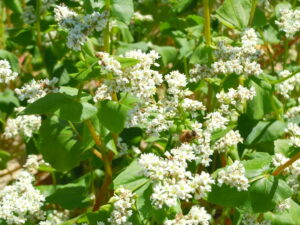 Now that some of our spring planted crops have finished, rather than leaving fields fallow or replanting fields that may have had some issues with plant diseases or insect pests, consider replanting with a summer cover crop. It is not too late to take advantage of summer cover crop benefits. What do summer cover crops do for soil health or future crop improvements? See below:
Now that some of our spring planted crops have finished, rather than leaving fields fallow or replanting fields that may have had some issues with plant diseases or insect pests, consider replanting with a summer cover crop. It is not too late to take advantage of summer cover crop benefits. What do summer cover crops do for soil health or future crop improvements? See below:
1. Increase Soil Organic Matter– One of the best attributes of having organic matter in the soil is improvement in soil structure. Adding organic matter improves tilth, water infiltration, water holding capacity, nutrient holding capacity and reduction of soil crusting. Also, as important is the increase in beneficial soil microbes and earthworms. Beneficial microbes can compete with pathogens and help release nutrients. Earthworms can cycle nutrients and improve pore spaces in the soil.
2. Reduce Soil Erosion – Just like with winter cover crops, summer cover crops can also reduce wind and water erosion in fields, especially those with slopes. During summer rainfall events, that can be significant if resulting from tropical storms, runoff may not just include soil loss, but also fertilizer and chemical movement. Therefore, keeping cover on a field during non-production times in any season is an excellent practice.
3. Nitrogen Cycling in the Soil – Nitrogen is often the most limiting nutrient for crop production, since it is so readily lost through nitrification and leaching. Storing nitrogen through plant cycling is an excellent way to improve fertility management. Whether it is a grass or non-leguminous cover crops N is still kept in the mix by the cover crop taking up residual N that would otherwise be lost. The cover crop plant takes up the nitrogen and after the crop is incorporated it decomposes, thus releasing the N for subsequent crops to use. If legume cover crops are planted, they have the ability to “fix” nitrogen from the atmosphere and through the same decomposition process will provide N for subsequent crops. Be sure to inoculate legume seed just prior to planting with Rhizobium bacteria in order to gain the maximum N fixation benefits.
otherwise be lost. The cover crop plant takes up the nitrogen and after the crop is incorporated it decomposes, thus releasing the N for subsequent crops to use. If legume cover crops are planted, they have the ability to “fix” nitrogen from the atmosphere and through the same decomposition process will provide N for subsequent crops. Be sure to inoculate legume seed just prior to planting with Rhizobium bacteria in order to gain the maximum N fixation benefits.
4. Reduce Weeds – When fields are left fallow after crops are harvested, weed growth can occur. If left to produce seeds, these weeds will multiply in subsequent crops. Therefore, managing the field by planting cover crops between cash crops is a great weed management option. As the cover crop grows, it will suppress the germination and growth of weeds through competition and shading. Some cover crop species can also suppress weeds biochemically, either while they are growing or while they are decomposing, which may prevent the germination or growth of other plants (allelopathy). Research has shown some cover crops like wheat, barley, oats, rye, sorghum, and sudangrass may suppress weeds. In some cases, it has also been reported that residues and leachates from crimson clover, hairy vetch, and other legumes have shown weed suppression.
5. Impacts on Plant Diseases – Cover crop residues could possibly be beneficial when it comes to plant pathogens, or can in some cases increase plant disease organisms. Some cover crop species are in the same plant families as cash crops and may be susceptible to the same disease organisms. Therefore, carrying the pathogen to the next crop. This is why paying attention to crop rotations is so important. In other cases, the cover crop residue can improve soil health in order to produce a better environment for beneficial microbes. By improving soil health, water infiltration, air pore space and other positive attributes, some soil pathogens may not survive as well, as in the case of water molds and water fungi. Some cover crops, like sorghum-sudangrass and sunnhemp, have been reported to reduce nematodes in soils. There are multiple positive factors from cover crops that can combat plant diseases.
6. Impacts on Insects – Like with plant diseases, cover crops can be susceptible to the same insect pests as cash crops. However, they may also attract beneficial insects into an area. Insect pests should be monitored in cover crops, just like in cash crops in order to not let populations get out of control and then move into nearby fields after the cover crop is killed.
For more resources on the us e of cover crops check out these resources: Cover Crops for Sustainable Crop Rotations – SARE
